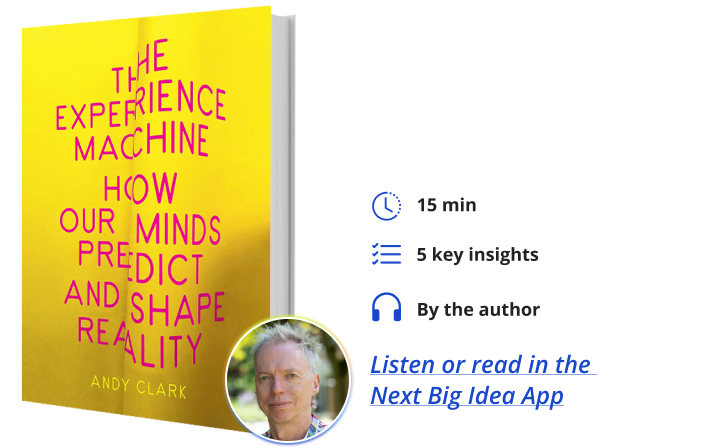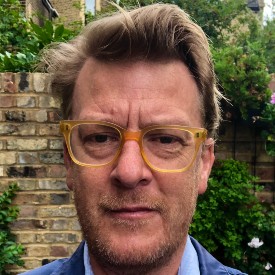Andy Clark is a Professor of Cognitive Philosophy at the University of Sussex and at Macquarie University, Australia. He is a Fellow of the Royal Society of Edinburgh and the British Academy and is an occasional Academic Consultant for Google, UK.
Below, Andy shares five key insights from his new book, The Experience Machine: How Our Minds Predict and Shape Reality. Listen to the audio version—read by Andy himself—in the Next Big Idea App.

1. Predictions shape experienced reality.
Imagine a world in which the weather forecast played a role (sometimes larger, sometimes smaller) in actually causing and bringing about the weather! We don’t live in that strange weather world. But if predictive processing accounts are correct, that’s the way human experience works. What we seem to sense and experience partially reflects the web of predictions (the “perceptual weather forecast” if you like) that the brain has learned from past encounters. The stronger those predictions, the more they pull experience in the directions they suggest. In the most extreme cases, strong predictions actually cause the experiences they forecast.
This means that perception is never a pure window into the world. Instead, our experiences are always and everywhere shaped and altered by our own—often hidden and unconscious —predictions and expectations.
Think about hearing a familiar song playing softly on the radio while you are in the shower. The familiar song will sound a lot clearer and crisper than an unfamiliar one. This is an example of what the brain does best. It is using what it already knows about how that specific song, as sung by that specific singer, is likely to sound to fill in the gaps. It is using prior knowledge to add (in a sense, to hallucinate) lots of confidently forecast sonic information, and also to dampen down interfering sound information from the shower.
Dramatically expressed, this means that everything we see, hear, touch, and feel involves what is sometimes described as a kind of “controlled hallucination.”
This is usually a good thing. It allows the brain to use what it knows to make a better guess about what’s going on out there in the world. Our brain’s predictions make up for incomplete and ambiguous information. But they also make experience hostage to those hidden predictions, too.
2. Strong enough predictions can make us hallucinate.
Predictive brains use what they know to shape experience. But when those predictions are too strong, we can seem to see, hear, and feel things that aren’t actually there, simply because the brain very strongly expects them.
There were hints of this in the shower example. But now consider something a little more striking—the experience of phantom phone vibrations. Quite often, especially if I am stressed, or expecting an important call, I seem to feel my cell phone vibrating in my pocket. But it is not actually ringing, and indeed, it may not be in my pocket at all! These “phantom phone vibrations” are a common experience and a clear case in which the hidden expectations of chronic long-term cell phone users can sometimes carve the experience of feeling those vibrations from whole cloth. This is like the shower example, but with dial-on prediction turned up extra high.
“Quite often, especially if I am stressed, or expecting an important call, I seem to feel my cell phone vibrating in my pocket.”
A famous series of lab experiments confirms this effect. The experiments date back to the 1960s but have been successfully repeated many times since. During these experiments, participants were played a sound file and told to push a button if they detected the faint start of Bing Crosby singing the song “White Christmas.” This was a trick, as the sound files were simply white noise, with no hints of Bing’s voice! Nonetheless, over 40 percent of participants thought they heard the start of the song.
According to predictive processing, phantom phone vibrations and the White Christmas experiments are simply dramatic examples of the way that we always perceive the world. Everything that we seem to hear, see, feel, and experience reflects whatever web of conscious and non-conscious predictions the brain happens to be applying. The stronger and more confident those predictions, the more they will pull experience in the directions they suggest, sometimes conjuring experience from expectation alone.
3. Our own bodily feelings reflect hidden predictions, too.
The predictive brain looks inwards as well as outwards and is constantly trying to predict the stream of sensations coming from within the body too. Our experiences of pain, for example, reflect a combination of the pain we expect and the actual signals coming from the body.
A striking example is the case of a New York City construction worker who fell from some scaffolding onto a large nail piercing his right foot. He experienced terrible pain and was given fentanyl before the doctors carefully removed the nail. They soon realized that the nail had not penetrated the foot at all, but had passed safely between the first and the second toe. The pain was real and excruciating. But (just like those phantom phone vibrations) it was rooted solely in the construction worker’s strong predictions.
This is another dramatic case. The deeper point, though, is that ordinary pain experiences are likewise constructed from complex mixtures of prediction and sensory information. When the dentist tells you that you will just feel a tickle, they are invoking that same mechanism, using it to dampen experienced pain.
The same broad picture may explain many cases of “medically unexplained symptoms”—cases of chronic pain, disability, and even blindness and paralysis where no standard bodily cause seems to be present. Many such cases have been shown to involve misfiring unconscious prediction machinery. Importantly, predictive processing helps us see that all human experience—even when standard medical causes operate—is built by the brain in this same broad way.
4. We can sometimes hack our own predictive brains.
All this has implications for human happiness and well-being. Recognizing the ways expectations shape experience, we can engage in practices that try to train and activate the hidden prediction machinery in ways that will help us feel better. For example, I often get a tingly feeling in my fingers before public talks and appearances. I have found it very helpful to re-frame that feeling not as a sign of anxiety and potential failure but as a sign of chemical readiness to deliver a good performance.
Placebo pills and procedures fall similarly into place. During the Second World War, when supplies of morphine were often short, it was discovered that administering a shot of saline solution instead often brought about significant amounts of relief. The soldier’s strong expectations of relief acted like self-fulfilling prophecies, causing genuine pain relief to occur.
“This is good evidence that many of the predictions that shape human experience are unconscious ones.”
Interestingly, so-called “honest placebos”—where the patient is actually told that the drug is a placebo—can also work. This is good evidence that many of the predictions that shape human experience are unconscious ones. These unconscious predictions can be automatically activated by the various details of packaging and presentation even when you, the patient, are fully aware you are being given a placebo.
Another hack involves what is known as “pain re-processing theory.” Here, sufferers of chronic pain are first taught about the power of the predictive brain, then slowly trained to re-frame their own pain experiences in more helpful ways, altering the hidden predictions that are shaping their experience. For example, it is easy to think that the experience of pain always means that continuing the current activity will cause bodily damage. Re-framing the pain as a kind of faulty warning signal caused by misfiring prediction circuitry can help people see past that, and start to do more. This positive experience then feeds back, improving self-expectations and diminishing levels of experienced pain.
Notice however that there are clear limits to the wiggle room provided by various attempts to hack our own predictive brains. There is no way that altering what we predict will heal a fracture, cure cancer, or kill a virus!
5. Predictive processing can help explain the diversity of human experience.
Predictive processing holds the promise of a much better understanding of the full range and variety of human experience. Autism Spectrum Condition, for example, seems to involve the brain over-emphasizing current sensory information at the expense of its own best predictions, causing anxiety and making faint patterns harder to detect. Conversely, many forms of psychosis involve over-active prediction machinery, causing us to see and hear whatever it is that our brains so strongly expect. Predictive processing has an effect on accounts of depression, anxiety, PTSD, and more.
Excitingly, we can now do this using a framework (Predictive Processing) that spans many levels. These accounts have been tested using computer simulations, they have detailed mappings of the structure and activity of the brain, and they capture a lot of lived human experience.
A theory like that might be one small step on the road to understanding not just the varieties of human experience but what human experience really is—how it flows from the activity of human brains, in human bodies, exploring our distinctively human worlds.
That is the holy grail. But at the very least, this picture of the mind as a prediction machine really helps explain a lot about our daily experiences.
To listen to the audio version read by author Andy Clark, download the Next Big Idea App today:































